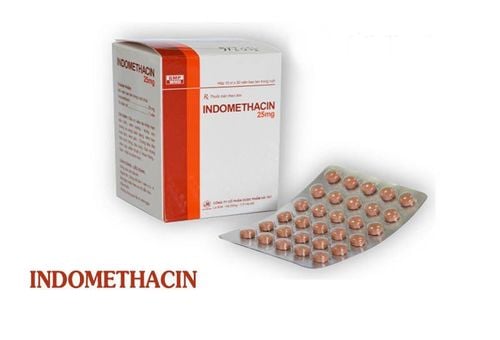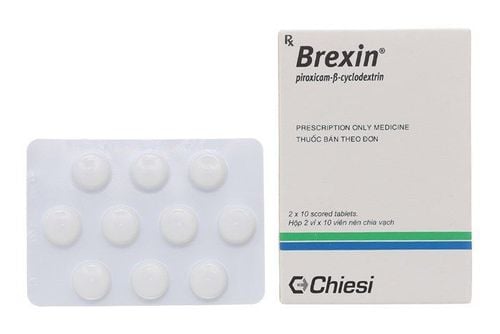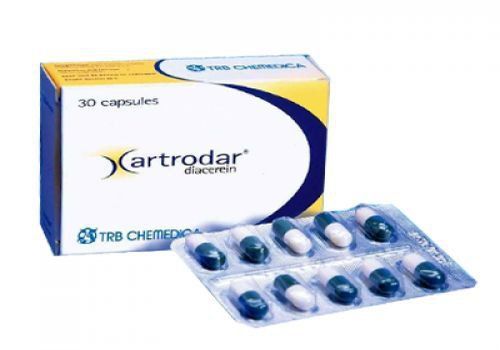This is an automatically translated article.
Etoricoxib is used for the symptomatic relief of osteoarthritis (OA), rheumatoid arthritis, ankylosing spondylitis, acute gouty arthritis, short-term treatment of moderate pain associated with dental surgery. Etoricoxib is the main active ingredient of Cefass 90.
1. What is Cefass 90?
Cefass 90 is a product of M/s Celogen Generics PVT, LTD, with the main ingredient being Etoricoxib, content 90mg, made in tablet form. Etoricoxib is a non-steroidal anti-inflammatory drug (NSAID) with anti-inflammatory, analgesic and antipyretic activity. Etoricoxib is a potent, selective, potent cyclooxygenase-2 (COX-2) inhibitor with high therapeutic activity when taken orally over and above the clinical dose range.
Studies have demonstrated that COX-2 has a major effect on the synthesis of prostanoic acid mediators of pain, inflammation and fever, and that etoricoxib's selective COX-2 inhibition reduces signs and symptoms clinical evidence for the patient, while reducing gastrointestinal toxicity, no effect on platelet function. Etoricoxib is well absorbed orally, with oral bioavailability close to 100%.
2. Uses of Cefass 90
Cefass 90 is indicated for use in adults and adolescents aged 16 years and older in the following cases:
Relief of symptoms in degenerative joint diseases, rheumatoid arthritis, ankylosing spondylitis ; Relieve pain and reduce inflammatory symptoms associated with acute gouty arthritis; Short-term treatment of moderate pain associated with dental surgery.
3. Dosage of Cefass 90
Cefass 90 can be taken on an empty stomach or on an empty stomach, but the initial response to Cefass 90 is faster if taken on an empty stomach. Because the cardiovascular risks and possible adverse effects of etoricoxib are likely to increase with dose and duration, Cefass 90 should be used for the shortest possible time and at a low dose. most effective. Symptomatic response to Cefass 90 should be re-evaluated periodically in patients with osteoarthritis.
Osteoarthritis: The recommended dose of Etoricoxib is 30mg once daily, which can be increased to 60mg once daily. Rheumatoid Arthritis: The recommended dose of Etoricoxib is 60 mg once daily, which may be increased to 90 mg once daily, after clinical stabilization is reduced to 60 mg once daily. Ankylosing spondylitis: The recommended dose of Etoricoxib is 60 mg once daily. If necessary, the dose of Cefass 90 can be increased to 90 mg once daily, after the patient is clinically stable, reduce the dose to 60 mg once daily. Analgesia in acute pain: Etoricoxib should be used only for the acute symptomatic period. Acute gouty arthritis: The recommended dose of Etoricoxib is 120 mg once daily. In clinical trials for acute gouty arthritis, Etoricoxib was administered for an 8-day period. Pain after dental surgery: The recommended dose of Etoricoxib is 90 mg once daily, with limited use for up to 3 days. Etoricoxib doses larger than the recommended dose have not been studied therefore:
The dose of Etoricoxib in arthritis should not exceed 60 mg of Etoricoxib per day; The dose of Etoricoxib for rheumatoid arthritis and ankylosing spondylitis should not exceed 90 mg of Etoricoxib per day. The dose of Etoricoxib for acute gouty arthritis should not exceed 120 mg of Etoricoxib per day for a maximum of 8 days. The dose of Etoricoxib for analgesia after acute dental surgery should not exceed 90 mg of Etoricoxib per day for a maximum of 3 days. Use of Cefass 90 in special populations:
Elderly patients: No dose adjustment of Cefass 90 is required for elderly patients, however, it should be used with caution in elderly patients. Patients with hepatic impairment: In patients with mild hepatic dysfunction (Child-Pugh score 5-6) Etoricoxib should not be used in excess of 60 mg once daily. In patients with moderate hepatic dysfunction (Child Pugh score 7-9), do not use Etoricoxib in excess of 30 mg once daily. There is no clinical experience in patients with severe hepatic dysfunction (Child-Pugh score ≥ 10); Therefore, the use of Cefass 90 is contraindicated. Patients with renal impairment: No dose adjustment of Cefass 90 is required for patients with creatinine clearance ≥ 30 ml/min, the use of etoricoxib or Cefass 90 in patients with creatinine clearance < 30 ml/min is contraindicated. Children: Cefass 90 is contraindicated in children and adolescents under 16 years of age.
4. Possible side effects when using Cefass 90
When using Cefass 90, patients may experience undesirable effects as follows:
4.1.Common side effects of Cefass 90 Drugs Infections, parasitic infections: Osteoarthritis; Metabolic: Edema, fluid retention; Nervous: Dizziness, headache; Circulatory: Palpitations, arrhythmias; Pulse: Increased blood pressure. Respiratory: Bronchospasm; Gastrointestinal: Abdominal pain, constipation, flatulence, gastritis, acid reflux, diarrhea, digestive disorders, nausea, esophagitis, mouth ulcers; Liver: Increased ALT, AST; Skin: Bruises; Weakness, fatigue like flu. 4.2. Side effects of Cefass 90 are uncommon Infections: Gastroenteritis, upper respiratory infections, urinary infections; Blood: Anemia, leukopenia, thrombocytopenia; Hypersensitivity. Increased/decreased appetite, weight gain. Anxiety, depression,; Taste disturbance, insomnia, paresthesia, somnolence; Tinnitus, dizziness; Hot flashes, cerebrovascular accident, transient ischemia, hypertension, vasculitis; Atrial fibrillation, tachycardia, congestive heart failure, angina, myocardial infarction; Cough, difficulty breathing; Epistaxis; Abdominal distention, altered bowel movements, peptic ulcer disease, irritable bowel syndrome, pancreatitis; Skin and tissues: Facial edema, pruritus, erythema, urticaria; Muscle spasticity/spasm, musculoskeletal pain/stiffness; There is proteinuria, increased serum creatinine, impaired renal function; Chest tightness. 4.3. Side effects of Cefass 90 are rare Allergy, angioedema, anaphylaxis including shock; Confusion, restlessness. Increase ALT, AST; Hepatitis B, jaundice; Stevens-Johnson syndrome; Decreased blood sodium.
5. Contraindications to Cefass 90
Hypersensitivity to any component of Cefass 90; Progressive peptic ulcer, gastrointestinal bleeding; The patient has taken aspirin or other NSAIDs; History of bronchospasm, acute rhinitis, nasal polyps; Pregnant and lactating women; Severe liver dysfunction; Creatinine clearance < 30ml/min; Children and adolescents < 16 years old; IBD; Congestive heart failure (grade II - IV - NYHA), ischemic heart disease, peripheral artery disease, cerebrovascular disease; Patients with hypertension higher than 140/90 mmHg that are not adequately controlled.
6. Be careful when using Cefass 90
Caution when using Cefass 90 with the following subjects:
Risk of cardiovascular thrombosis; Effects on the gastrointestinal tract; Affects the kidneys; Fluid retention, edema, high blood pressure; Affects the liver; If, during treatment with Cefass 90, any of the above organ system functions worsen, then appropriate measures should be taken and discontinuation of Etoricoxib should be considered.
7. Drug interactions of Cefass 90
Some Cefass 90 drug interactions include:
Oral anticoagulant warfarin: oral administration of Etoricoxib 120 mg daily may lead to an approximately 13% increase in prothrombin INR, patients taking anticoagulants should be closely monitored. prothrombin time INR; Diuretics, ACE inhibitors, angiotensin II antagonists: NSAIDs may reduce the effect of diuretics and antihypertensives; Acetylsalicylic acid: Oral etoricoxib 120 mg once daily had no effect on the antiplatelet activity of acetylsalicylic acid (81 mg once daily). However, co-administration of low-dose acetylsalicylic acid with etoricoxib may increase the incidence of peptic ulcers or other complications; Lithium: NSAIDs reduce renal excretion of lithium, increasing plasma lithium concentrations; Methotrexate: Etoricoxib 60 and 90 mg doses had no effect on methotrexate plasma concentrations or renal clearance; a 120 mg dose of Etoricoxib resulted in a 28% increase in methotrexate plasma concentrations and a 13% decrease in methotrexate renal clearance. Etoricoxib is used for the symptomatic relief of osteoarthritis (OA), rheumatoid arthritis, ankylosing spondylitis, acute gouty arthritis, and for the short-term treatment of moderate pain associated with surgery. dental art. To ensure effective use and avoid side effects, patients need to take the drug exactly as directed by the doctor.
Follow Vinmec International General Hospital website to get more health, nutrition and beauty information to protect the health of yourself and your loved ones in your family.
Please dial HOTLINE for more information or register for an appointment HERE. Download MyVinmec app to make appointments faster and to manage your bookings easily.













